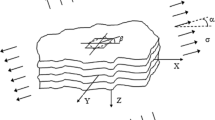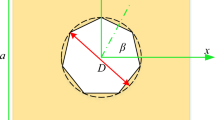Abstract
To maximize buckling loads of composite laminates, optimization is carried out using a Genetic algorithm (GA) in conjunction with finite element analysis. A perforated laminated composite plate is used for buckling analysis. The geometry is discretized into solid threedimensional twenty node isoparametric layered composite elements developed for this study. Fiber orientations of each element and individual plies are controlled independently by the genetic algorithm, which is especially advantageous for complex problems including many design variables. This approach for composite buckling produces more enhanced results than conventional methods, such as changing the stacking sequence of various rectilinear orthotropic plies with different fiber orientations, different ply thicknesses or different local fiber densities. Additionally, it can be used in diverse areas from sensitive local buckling to global stability of structures. The genetic algorithm, finite element analysis and eigen buckling analysis are numerically combined into a composite optimization code, COMBO20. The successful performance of the proposed approach is demonstrated with an example.
Similar content being viewed by others
References
H. A. Qablan, H. Katkhuda and H. Dwairi, Assessment of the buckling behavior of square composite plates with circular cutout subjected to in-plnae shear, Jordan J. of Civil Engineering, 3 (2) (2009) 184–195.
T. Ungwattanapanit and H. Baier, Strength-stability optimization of hybrid-stiffness laminated plates with cut-outs subjected to multiple loads, Royal Aeronautical Society 3rd Aircraft Structural Design Conference, Delft, Netherlands (2012).
R. Spallino and G. Thierauf, Thermal buckling optimization of composite laminates by evolution strategies, Computers & Structures, 78 (5) (2000) 691–697.
M. W. Hyer and R. F. Charette, The use of curvilinear fiber format in composite structure design, 30th AIAA SDM Conference, Paper No. 89-1404, Mobile, AL (1989).
A. Teter and S. Samborski, Buckling of thin-walled plates made of curvilinear fibre reinforced composite under uniaxial compression, Computer Methods in Mechanics Conference, Poznan, Poland (2013).
A. Todoroki and M. Sasai, Improvement of design reliability for buckling load maximization of composite cylinder using genetic algorithm with recessive-gene-like repair, JSME Internal J. Series A, 42 (4) (1999) 530–536.
R. Spallino and G. Thierauf, Thermal buckling optimization of composite laminates by evolution strategies, Computers & Structures, 78 (2000) 691–697.
L. R. Riche and R. T. Haftka, Optimization of laminate stacking sequence for buckling load maximization by genetic algorithm, AIAA J., 31 (5) (1993) 951–956.
J. H. Kang and C. G. Kim, Minimum weight design of compressively loaded composite plates and stiffened panels for postbuckling strength by genetic algorithm, Composite Structures, 69 (2005) 239–246.
J. H. Holland, Genetic algorithms and machine learning, Machine Learning, 3 (1988) 95–99.
D. E. Goldberg, Genetic algorithms in search optimization & machine learning, Addison Wesley, New York USA (1989).
G. Soremekun, Z. Gürdal, R. T. Haftka and L. T. Watson, Composite laminate design optimization by genetic algorithm with generalized elitist selection, Computers & Structures, 79 (2001) 131–143.
Z. Gürdal, R. T. Haftka and P. Hajela, Design and optimization of laminated composite materials, Wiley Interscience (1999).
S. Adali, A. Richter, V. E. Verijenko and E. B. Summers, Optimal design of hybrid laminates with discrete ply angles for maximum buckling load and minimum cost, Composite Structures, 32 (1995) 409–415.
G. H. Staab, Laminar Composites, Butterworth Heinmann (1999).
K. J. Bathe, Finite element procedures in engineering analysis, Prentice Hall (1982).
J. N. Reddy, Mechanics of laminated composite plates: theory and analysis, CRC press (1997).
H. K. Cho and R. E. Rowlands, Minimizing stress concentrations in laminated composites by genetic algorithm, Proc. of International Mechanical Engineering Congress and Exposition, Orlando, FL, USA (2005).
K. J. Bathe and E. L. Wilson, Solution methods for eigenvalue problems in structural mechanics, International J. for Numerical Methods in Engineering, 6 (1973) 213–226.
K. J. Bathe, Solution methods for large generalized eigenvalue problems in structural engineering, Report UC SESM 71-20, Civil engineering Department, University of California, Berkeley (1971).
D. B. Adams, L. T. Watson, Z. Gürdal and C. M. Anderson-Cook, Genetic algorithm optimization and blending of composite laminates by locally reducing laminate thickness, Advances in Engineering Software, 35 (2004) 35–43.
Z. Michalewicz, Genetic algorithms + data structures evolution programs, Springer (1996).
R. T. Haftka and Z. Gürdal, Elements of structural optimization, Kluwer Academic Publishers (1992).
J. W. Whitney, I. M. Daniel and R. B. Pipes, Experimental mechanics of fiber reinforced composite materials, SEM Monograph #4, SEM/Prentice Hall (1994).
M. W. Hyer and H. H. Lee, The use of curvilinear fiber format to improve buckling resistance of composite plates with central circular holes, Composite Structures, 18 (1991) 239–261.
K. Chandrashekhara and K. Bhatia, Active buckling control of smart composite plates-finite element analysis, Smart Materials and Structure, 2 (1993) 31–39.
M. Goldmanis and A. Riekstinsh, Post-buckling finite element analysis of composite cylindrical panels in axial compression, Composite Structures, 29 (1994) 457–462.
C. S. Babu and T. Kant, Refined higher order finite element models for thermal buckling of laminated composite and sandwich plates, J. of Thermal Stresses, 23 (2000) 111–130.
K. D. Kim, Buckling behavior of composite panels using the finite element method, Composite Structures, 36 (1996) 33–43.
K. Kogiso, L. T. Watson, Z. Gurdal, R. T. Haftka and S. Nagendra, Minimum thickness design of composite laminates subject to buckling and strength constraints by genetic algorithms, Proc. of the 35th AIAA/ASME/ASCE/ AHS/ASC Structures, Structural Dynamics & Materials Conference, 4 (1994) 2257–2275.
C. C. Lin and Y. J. Lee, Stacking sequence optimization of laminated composite structures using genetic algorithm with local improvement, Composite Structures, 63 (2004) 339–345.
G. Lee, J. Park and D. H. Choi, Shape optimization of mobile phone folder module for structural strength, Journal of Mechanical Science and Technology, 26 (2) (2012) 509–515.
W. Hu, I. Han, S. C. Park and D. H. Choi, Multi-objective structural optimization of a HAWT composite blade based on ultimate limit state analysis, JMST, 26 (1) (2012) 129–135.
Author information
Authors and Affiliations
Corresponding author
Additional information
Recommended by Associate Editor Heung Soo Kim
Hee Keun Cho received his B.S. and M.S. degree in mechanical engineering from Yeungnam University in 1996 and Kyungpook National University in 1998, respectively. He then completed his Ph. D. degree at the University of Wisconsin- Madison USA in 2006 in the field of composite materials. Dr. Cho is currently an associate professor at Andong National University, South Korea. His research is focused on composite material, dynamics, optimization and CAE.
Rights and permissions
About this article
Cite this article
Cho, H.K., Rowlands, R.E. Enhancing buckling performance of perforated composite laminates by manipulating fiber direction using a genetic algorithm. J Mech Sci Technol 29, 3727–3737 (2015). https://doi.org/10.1007/s12206-015-0818-2
Received:
Revised:
Accepted:
Published:
Issue Date:
DOI: https://doi.org/10.1007/s12206-015-0818-2




